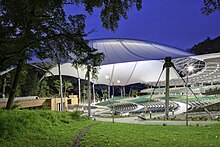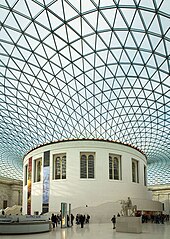
Back Йăлхах (хăтлав механики) CV Schale (Technische Mechanik) German Koorik (tugevusõpetus) Estonian Coque (structure) French Cuncha (estrutura) Galician Թաղանթ Armenian ЧӀибал (гӀишлонхой механика) INH Оболочка (строительная механика) Russian Оболонка (механіка) Ukrainian



A shell is a three-dimensional solid structural element whose thickness is very small compared to its other dimensions. It is characterized in structural terms by mid-plane stress which is both coplanar and normal to the surface. A shell can be derived from a plate in two steps: by initially forming the middle surface as a singly or doubly curved surface,[1] then by applying loads which are coplanar to the plate's plane thus generating significant stresses. Materials range from concrete (a concrete shell) to fabric (as in fabric structures).
Thin-shell structures (also called plate and shell structures) are lightweight constructions using shell elements. These elements, typically curved, are assembled to make large structures. Typical applications include aircraft fuselages, boat hulls, and the roofs of large buildings.
- ^ O.C. Zienkiewicz and R.L. Taylor. The finite element method for solid and structural mechanics.